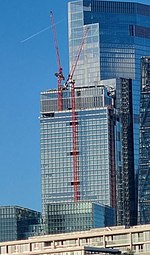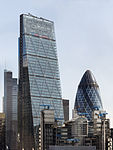Gibson Hall, London

The Gibson Hall is a Grade I listed building on Bishopsgate in the City of London. The building is named after its architect, John Gibson. Built of Portland stone in the classical style with engaged Corinthian columns, the building was commissioned as a new head office by the directors of the National Provincial Bank of England and completed in 1865.The exterior elevation features eight panels of allegorical scenes in high relief representing the achievements of mankind: the Arts, Commerce, Science, Manufactures, Agriculture, Navigation, Shipbuilding and Mining. Standing figures along the roof line represent various important cities in which the bank did business, including Manchester, Birmingham, Dover, Newcastle and London. The building was listed in 1950, for its special architectural and historic interest.In 1967, National Provincial Bank moved its head office to Drapers Gardens, 12 Throgmorton Avenue. Since its disposal by National Westminster Bank in 1998, 15 Bishopsgate has been operating solely as an events hosting venue available for hire to the general public.
Excerpt from the Wikipedia article Gibson Hall, London (License: CC BY-SA 3.0, Authors, Images).Gibson Hall, London
Bishopsgate, City of London
Geographical coordinates (GPS) Address External links Nearby Places Show on map
Geographical coordinates (GPS)
| Latitude | Longitude |
|---|---|
| N 51.5147 ° | E -0.0836 ° |
Address
Gibson Hall
Bishopsgate 13
EC2N 4AW City of London
England, United Kingdom
Open on Google Maps







